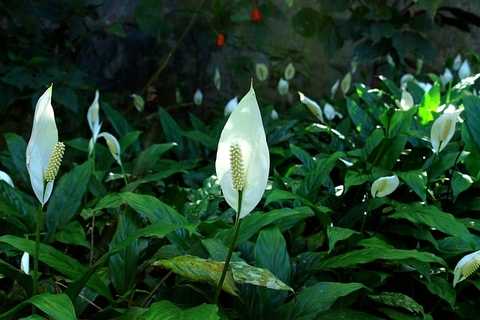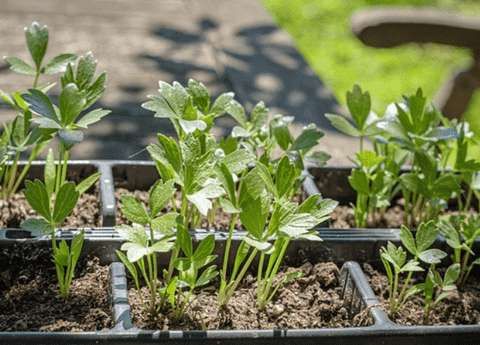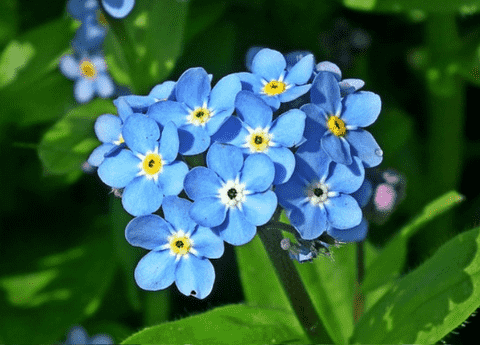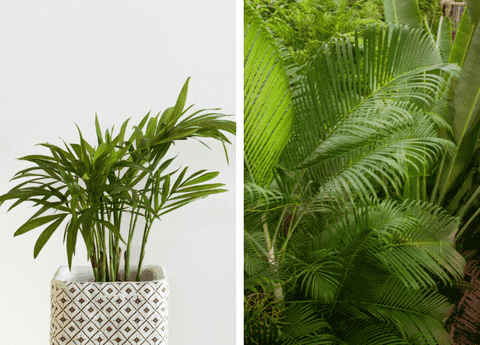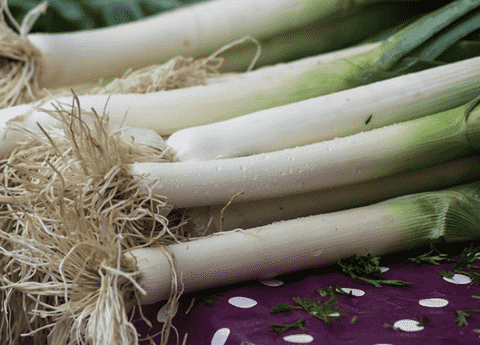Guide for How to Grow and Care for Peace Lily (Spathiphyllum)
Table of Contents
Peace Lilies (Spathiphyllum) are elegant and resilient houseplants that have become a popular choice for both novice and experienced gardeners alike. Known for their lush, dark green foliage and striking white blooms, these plants can add a touch of tranquility to any indoor space. In this guide, we will delve into the essential steps for growing and caring for Peace Lilies, covering everything from optimal lighting and watering practices to common issues and solutions. Whether you’re looking to enhance your home with natural beauty or simply enjoy the process of nurturing a living plant, this comprehensive guide will equip you with all the knowledge you need to keep your Peace Lily thriving.
Introduction to Peace Lily
Overview of Peace Lily
Peace Lilies, scientifically known as Spathiphyllum, are tropical, evergreen plants that thrive in warm environments. Native to the rainforests of Central and South America, these plants are known for their adaptability and low-maintenance nature. Peace Lilies feature broad, dark green leaves and elegant, white flowers known as spathes, which resemble a hooded shape surrounding a central spadix. They are particularly valued for their air-purifying qualities, making them an excellent addition to indoor spaces. Typically, Peace Lilies grow to about 1 to 4 feet in height, depending on the species and growing conditions. Given the right care, these plants can bloom throughout the year, adding a continuous touch of elegance to your home or office. With their combination of beauty and resilience, Peace Lilies are an ideal choice for anyone looking to cultivate an indoor garden.
Benefits of Growing Peace Lily
Growing Peace Lilies offers numerous benefits beyond their aesthetic appeal. One of the most significant advantages is their ability to improve indoor air quality. NASA’s Clean Air Study revealed that Peace Lilies can effectively remove common household toxins like formaldehyde, benzene, and trichloroethylene from the air. This makes them an excellent choice for homes and offices seeking a healthier environment. Additionally, Peace Lilies are low-maintenance, requiring minimal care, which makes them perfect for busy individuals or those new to gardening. Their lush green foliage and striking white blooms can enhance the visual appeal of any space, adding a touch of nature’s tranquility. Moreover, Peace Lilies can also contribute to better mental well-being by providing a sense of accomplishment and reducing stress levels. Overall, growing Peace Lilies can enrich your living or working space both aesthetically and functionally.
Common Varieties
Peace Lilies come in several varieties, each with its own unique characteristics. The most common type is Spathiphyllum ‘Mauna Loa’, known for its large, glossy leaves and abundant white flowers. Another popular variety is Spathiphyllum ‘Sensation’, which is the largest, capable of growing up to 4 feet tall and featuring broader leaves. For those who prefer a more compact plant, Spathiphyllum ‘Wallisii’ is an excellent choice, growing to about 1 to 2 feet in height with narrower leaves. Spathiphyllum ‘Domino’ is a unique variety distinguished by its variegated foliage, with striking white streaks running through its green leaves. Each of these varieties shares the general care requirements typical of Peace Lilies but offers different visual and spatial benefits. Selecting the right variety can depend on your specific space constraints and aesthetic preferences, ensuring that you find the perfect fit for your home or office.
Growing Peace Lily
Ideal Growing Conditions
Peace Lilies thrive in specific growing conditions that mimic their natural tropical habitat. These plants prefer indirect, filtered light, making them ideal for areas with moderate to low light levels. Direct sunlight can scorch their leaves, so it’s best to place them near windows with sheer curtains or in well-lit rooms away from the sun’s harsh rays. In terms of temperature, Peace Lilies flourish in a range of 65-80°F (18-27°C), which aligns well with typical indoor environments. They also appreciate high humidity levels, reminiscent of their rainforest origins. To achieve this, you can occasionally mist the leaves or place the pot on a tray of pebbles with water. Additionally, Peace Lilies prefer well-draining soil that retains some moisture without becoming waterlogged. Using a high-quality potting mix with good aeration will help maintain the right balance. By providing these ideal growing conditions, you can ensure that your Peace Lily remains healthy and vibrant.
Planting Peace Lily
Planting a Peace Lily involves a few straightforward steps to ensure it establishes well in its new environment. Begin by selecting a pot with drainage holes to prevent water from accumulating at the bottom, which can cause root rot. Fill the pot about one-third full with a high-quality, well-draining potting mix. Carefully remove the Peace Lily from its current container, gently loosening the roots if they are compacted. Place the plant in the new pot, ensuring that the top of the root ball is about an inch below the rim of the pot. Fill in around the root ball with more potting mix, pressing it down lightly to eliminate air pockets. Water the plant thoroughly until water flows out of the drainage holes, and then let it drain completely. Finally, place the newly potted Peace Lily in a location with indirect light and maintain consistent care to help it adapt to its new home.
Watering and Fertilizing
Proper watering and fertilizing are crucial for maintaining a healthy Peace Lily. These plants thrive in consistently moist soil but are sensitive to overwatering. Water your Peace Lily when the soil’s surface feels dry within the top inch. Ensure thorough watering and let any excess water drain out of the pot to avoid waterlogging. If the leaves start to droop, it’s often a signal that the plant needs water, but they usually perk up quickly once hydrated.
Fertilizing should be done sparingly. Use a balanced, water-soluble fertilizer diluted to half strength every six to eight weeks during the growing season, typically from spring through early fall. Avoid fertilizing during the winter months when the plant’s growth slows down. Over-fertilizing can lead to salt build-up in the soil, which can damage the roots and cause leaf burn. By following these watering and fertilizing guidelines, you can keep your Peace Lily lush and thriving.
Caring for Peace Lily
Common Pests and Diseases
Peace Lilies are generally resilient, but they can sometimes fall prey to common pests and diseases. Spider mites, aphids, and mealybugs are the most frequent pests. These insects can be controlled by wiping the leaves with a damp cloth or using insecticidal soap. Regularly inspecting your plant will help catch infestations early.
In terms of diseases, Peace Lilies are susceptible to root rot, particularly if they are overwatered. Ensuring proper drainage and not allowing the plant to sit in water are key preventative measures. Another common issue is leaf spot disease, which presents as brown or yellow spots on the leaves. This can be caused by fungal or bacterial infections, often due to high humidity and poor air circulation. Removing affected leaves and improving airflow around the plant can help mitigate this problem. By staying vigilant and addressing issues promptly, you can keep your Peace Lily healthy and vibrant.
Pruning and Repotting
Pruning and repotting are essential tasks to maintain the health and appearance of your Peace Lily. Pruning involves removing yellow, brown, or dead leaves to encourage new growth and keep the plant looking tidy. Use clean, sharp scissors or pruning shears to cut the leaves as close to the base as possible. Additionally, spent flowers should be removed promptly to divert the plant’s energy back to foliage growth.
Repotting your Peace Lily is necessary when it outgrows its current container, typically every 1-2 years. Signs that indicate the need for repotting include roots growing out of the drainage holes or the plant becoming root-bound. To repot, select a pot that is one size larger than the current one. Gently remove the plant from its old pot, loosen the roots, and place it in the new container with fresh potting mix. Water thoroughly and return it to its original location. Regular pruning and timely repotting will promote optimal growth for your Peace Lily.
Troubleshooting Issues
Despite being low-maintenance, Peace Lilies can sometimes face a few issues. Yellowing leaves frequently indicate excessive watering or inadequate drainage. Ensure the pot has proper drainage holes and adjust your watering routine. If the leaves develop brown tips, this may indicate low humidity, underwatering, or exposure to direct sunlight. Increasing humidity levels and ensuring the plant is not in direct sunlight can help rectify this.
Drooping leaves typically signal that the plant needs water, but they should perk up soon after watering. If the problem persists, check for root rot or pests. Spathiphyllum can also suffer from nutrient deficiencies, which manifest as pale or yellow leaves. Applying a well-balanced, water-soluble fertilizer throughout the growing season can be beneficial.
Lastly, if your Peace Lily is not blooming, it might not be getting enough light. Moving the plant to a brighter location with indirect light can encourage flowering. Regularly monitoring and adjusting care routines can resolve most issues, keeping your Peace Lily healthy.

